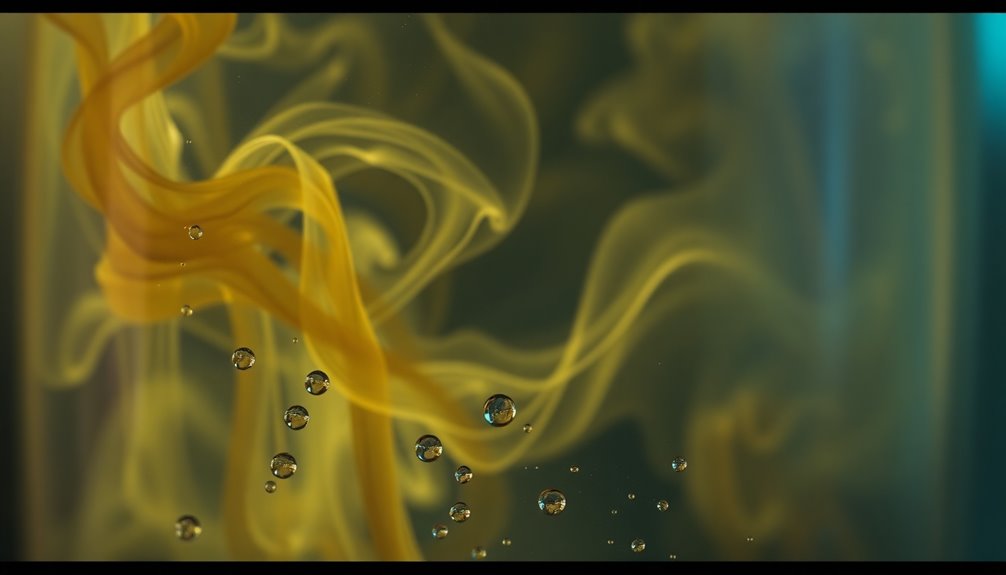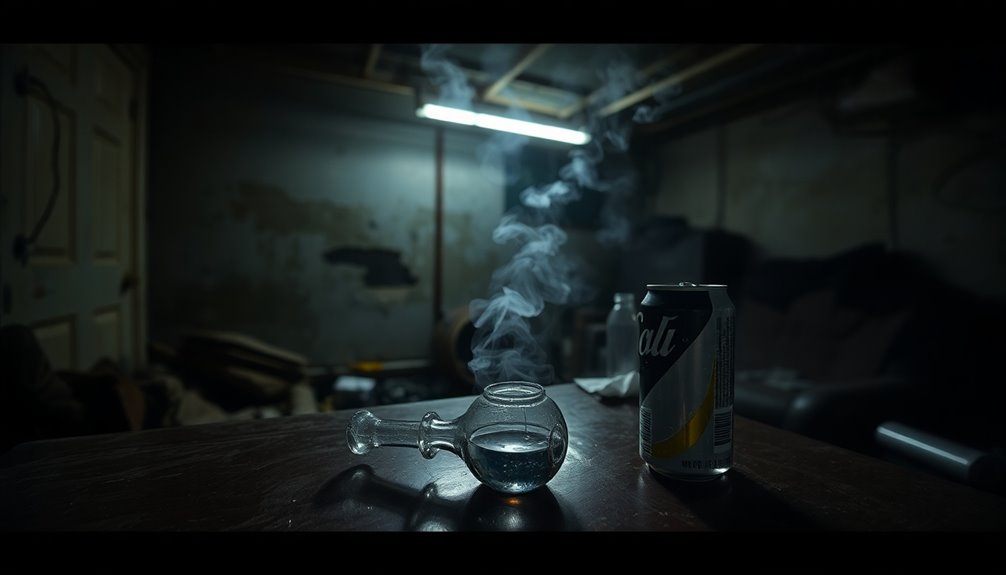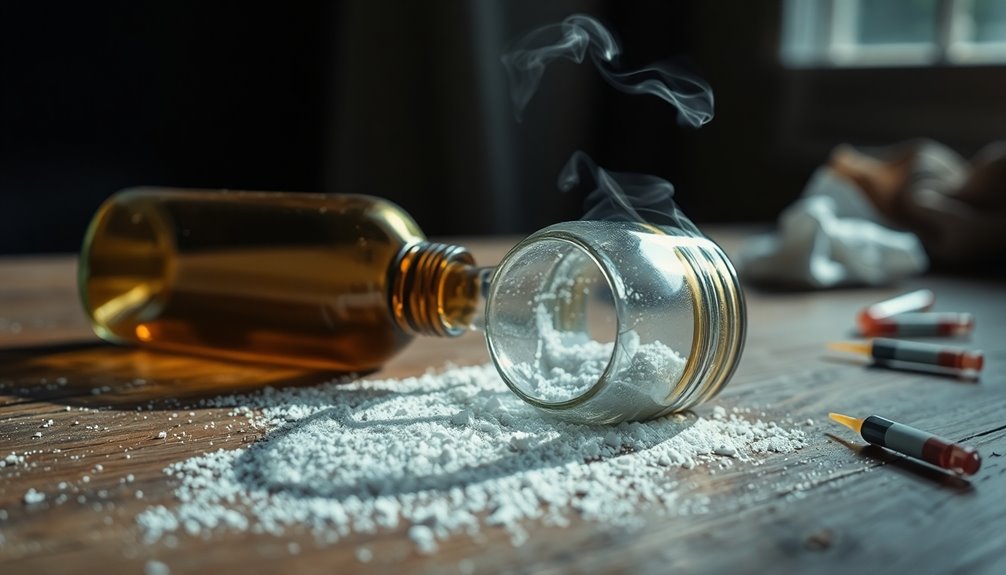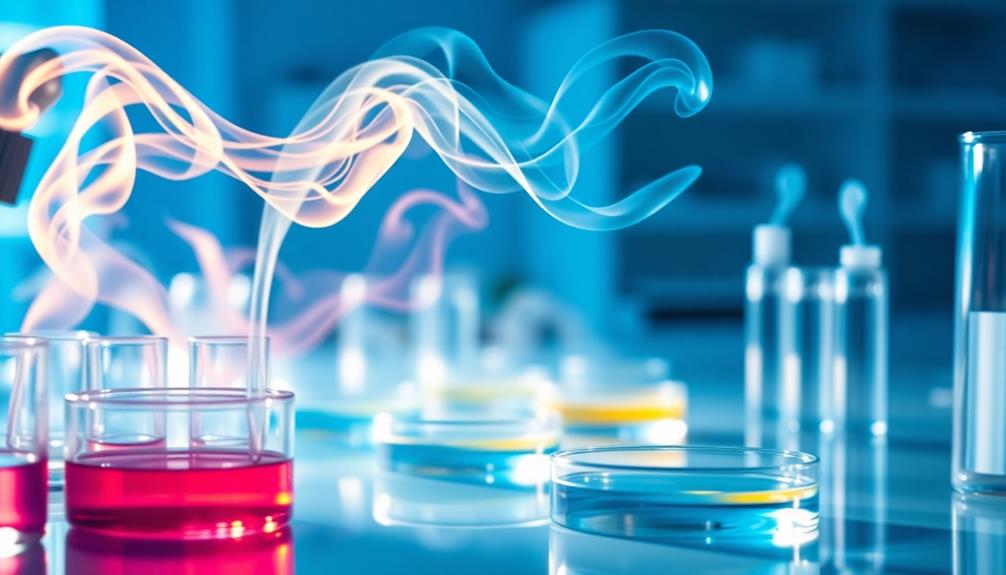If you're curious about what meth smells like, it really depends on how it's used. Smoked meth has a lighter, sweet odor that might remind you of chemical cleaners. On the other hand, if meth is being produced, the smell is much worse—think rotten eggs, cat urine, and harsh cleaning supplies. These odors can signal serious health risks, so being aware of them is crucial. If you notice these scents, it's best to be vigilant and consider the context. Stick around, and you might uncover more details about the impacts and signs related to meth use.
Key Takeaways
- Smoked meth has a lighter, sweet scent similar to chemical cleaners, while production odors are pungent and unpleasant.
- Production smells can resemble rotten eggs, cat urine, and strong chemical cleaners, indicating a potential meth lab.
- Exposure to meth production odors may cause respiratory issues, headaches, and skin irritations, particularly affecting children.
- Signs of meth activity include drawn curtains, odd late-night activities, and unusual visitation patterns, along with strong chemical odors.
- Reporting suspected meth production is crucial for community safety, as toxic fumes can impact both residents and passersby.
Introduction

Methamphetamine, commonly known as meth, has a distinct smell that can be alarming if you encounter it. This smell varies significantly based on how the drug is used or produced. When smoked, you might notice a lighter, sweeter scent that resembles powerful chemical cleaning products or even vinegar. However, the odor associated with meth production is far more pungent and less pleasant. It's often described with strong chemical scents reminiscent of window cleaner, rotten eggs, and even cat urine, due to the dangerous chemicals involved in its synthesis.
You might find that recognizing the smell of meth can be vital for your safety. The specific odors can change based on the materials used during production, leading to distinct and recognizable scents in the environment. If you come across a smell that matches these descriptions, it could indicate meth-related activities in your neighborhood. Being aware of these chemical scents can prompt you to take caution or report suspicious activities, helping to maintain a safer community. Understanding the unique smell of methamphetamine is an essential step in staying informed and vigilant.
Description of the Smell

Recognizing these smells is crucial, as they can point to potential health risks. If you encounter such odors, seeking medical advice is a vital first step, especially if you or someone else has existing health conditions. Staying alert to these signs can help protect your well-being and that of your community. Remember, awareness can make a significant difference in identifying potential dangers linked to meth use and production.
Source and Composition

In the world of illicit drug production, the source and composition of methamphetamine are crucial to understanding its distinctive smells. Meth is often synthesized using a variety of dangerous chemicals like acetone, anhydrous ammonia, hydrochloric acid, lithium, and red phosphorus. Each of these substances contributes to the unique odors associated with meth production.
You might notice that the smell of meth production is frequently compared to window cleaner, rotten eggs, or even cat urine. This is primarily due to the presence of ammonia and other volatile compounds. When meth is smoked, it gives off a lighter, sweeter odor reminiscent of strong chemical cleaners or a blend of vinegar and ammonia. It's important to realize that the specific production process and materials used can significantly alter the scent profile of meth, leading to variations in smell.
However, it's not just the smell that's concerning. The chemical odors from meth production can pose serious health risks, including respiratory problems and neurological damage for those nearby. Understanding the source and composition of meth is essential for recognizing the dangers associated with its production and use.
Typical Scenarios or Environments

When you come across environments where meth is used or produced, specific signs can alert you to potential activity. For instance, if you notice homes with drawn curtains and residents exhibiting paranoia or excessive energy, it could indicate meth use. Odd late-night activities may also raise suspicions about what's happening inside.
If you're near a meth lab, the chemical odors can be quite striking. You might catch whiffs reminiscent of strong cleaning products, vinegar, or even a "hospital smell." This can be a telltale sign of production activities.
Additionally, keep an eye out for unusual visitation patterns at odd hours. Frequent visitors, especially at night, might suggest something illicit is occurring. You may also spot paraphernalia like burnt spoons or pipes scattered around.
In neighborhoods with meth lab activity, you might see dead patches in lawns and an increase in trash, particularly empty chemical containers. These elements combined with strong, unpleasant odors can indicate that you're in a meth-affected area. Always trust your instincts and report any concerning observations to local authorities for safety.
Emotional or Cultural Associations

The distinctive smell of meth often triggers profound emotional responses, linking it to fear and danger in communities grappling with addiction. When you catch a whiff of those noxious odors, it's hard not to feel a sense of unease. This scent is more than just a chemical; it's a reminder of the stigma surrounding drug use and the chaos it can bring to neighborhoods.
Cultural portrayals in media amplify these feelings, usually depicting meth as a destructive substance tied to crime and decay. If you live in an area with high meth production, the smell might create a shared awareness among residents, fostering a community vigilance. You may find yourself more alert, concerned about public safety as you navigate daily life.
The unpleasant odors from meth labs can also lead to social withdrawal, as distrust grows among neighbors. However, this awareness can spark collective action. When you and your community rally together to report suspicious activities, it reflects a commitment to advocating for public health and safety, transforming fear into empowerment.
Health or Safety Considerations

Living in an area affected by meth production can pose serious health risks. The strong chemical odors emitted during meth production, resembling window cleaner, rotten eggs, or cat urine, indicate potential exposure to toxic fumes. If you live near a meth lab, you might experience respiratory problems, headaches, or skin irritations. Prolonged exposure could even lead to long-term neurological damage.
Children are particularly vulnerable. Being in environments where meth is produced puts them at an increased risk for developmental delays and mental health issues, such as anxiety and depression. It's critical to recognize these dangers and take them seriously.
If you suspect meth production in your neighborhood, report the activity to law enforcement immediately. Protecting your community's safety is essential, as toxic fumes can affect neighbors and passersby, creating serious health complications.
Moreover, if you're considering moving into a property previously used as a meth lab, be aware of the hidden health risks from leftover contamination. A thorough property inspection is vital before occupancy to ensure a safe living environment. Your health and safety should always come first.
Final Thoughts

Understanding the distinct smells associated with meth is crucial for your safety and the well-being of your community. When meth is smoked, you might notice a sweet, chemical odor akin to cleaning products, vinegar, or ammonia—often described as a "hospital smell." However, the smell produced during meth production is much stronger and can resemble window cleaner, rotten eggs, or even cat urine due to the hazardous chemicals involved in the process.
Be aware that the specific materials and methods used can lead to variations in these odors, making it vital to pay attention to your surroundings. If you detect strong chemical odors in your neighborhood, it could signal possible meth lab activity. In such cases, it's important to exercise caution and consider reporting your observations to local authorities.
Frequently Asked Questions
What Drug Smells Like Skunk?
If you're wondering what drug smells like skunk, you're likely thinking about marijuana. Certain potent cannabis strains emit a strong skunky odor, especially when broken apart or heated. This scent comes from sulfur compounds, which create that distinctive aroma. Some hashish or concentrates can also have a similar smell, depending on how they're made. The intensity of the skunk smell varies, with some finding it pleasantly pungent while others may find it overwhelming.
What Drugs Smell Like Sulfur?
If you encounter a sulfur smell, it might indicate the presence of certain drugs. Methamphetamine often emits a rotten egg odor due to chemicals used in its production. Other substances, like some synthetic opioids and certain psychedelics, can also produce similar smells when improperly synthesized. If you notice this odor, it's a red flag for contamination or dangerous conditions, so it's best to steer clear and prioritize your safety.
What Does Methylamine Smell Like?
Methylamine's smell hits you with a strong, pungent odor that's often compared to ammonia or a fishy scent. If you come across it, you'll likely find the smell overwhelming, making it hard to ignore. This chemical compound lingers in the air, so you'll notice it in environments where it's present. Be cautious, as exposure can irritate your respiratory system and skin, highlighting its potential dangers in industrial settings.









